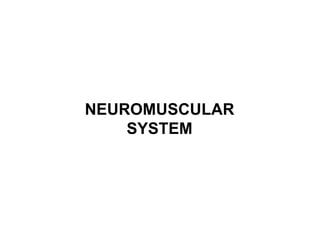
Neuromuscular System
- 2. MUSCULAR SYSTEM Anterior Posterior
- 3. MUSCULAR SYSTEM Smooth Muscle Cardiac Muscle Skeletal Muscle
- 4. MUSCULAR SYSTEM Smooth Muscle Found in the digestive, circulatory, urinary and reproductive systems Controlled by the autonomic nervous system Smooth in appearance Involuntary controlled
- 6. Contraction of the heart is controlled by the sinoatrial node (SAN)
- 7. Striated (striped) in appearance
- 9. Controlled by the somatic nervous system
- 12. SKELETAL MUSCLE ANATOMY Skeletal muscle is made up of fibres: Made up of smaller myofibrils Within each myofibril are strands of myofilaments (actin and myosin) Fibres grouped together are called fasciculi Fasciculi are then grouped together to form the muscle
- 13. SKELETAL MUSCLE ANATOMY Endomysium – surrounds each muscle fibre Perimysium – surrounds each fasciculi Epimysium – covers entire muscle
- 14. fascia surrounds the muscle connected to periosteum (bone) Epimysium the outer layer perimysium around each bundle offibres endomysium around each muscle fibre muscle fibre myofibril muscle filament SKELETAL MUSCLE ANATOMY
- 15. SLIDING FILAMENT THEORY Myofilamentsactin (thin) and myosin (thick) do not decrease in length when a muscle contracts. They simply slide over each other thus shortening the entire muscle. The myosin filaments have golf club shaped heads which attach onto the actin and pull the actin closer together (as detailed in picture on next slide)
- 16. SLIDING FILAMENT THEORY myosin actin myosin cross-bridges attach to the actin filaments actin is pulled together and sarcomere length is reduced
- 18. NEUROLOGICAL SYSTEM The Central Nervous System The Brain and Spinal Cord The Peripheral Nervous System
- 19. THE REFLEX ARC Central Nervous System Sensory Receptor Sensory Nerve Motor Nerve Muscle responds to nerve impulses
- 21. ‘All or none law’ – when a motor neuron is stimulated, ALL of the muscle fibres are activated
- 22. The more motor units that are recruited for a task, the greater the force will be developed
- 24. Antagonist- The opposing muscle that relaxes in order to allow the movement to occur
- 25. Synergist- A muscle that assists the agonist in producing movement
- 28. E.g. Lifting a dumbell during a bicep curl
- 29. Eccentric (negative); the muscle contracts and lengthens to control a resistance
- 30. E.g. Lowering a dumbell during a bicep curl
- 31. Isometric(static); the muscle contracts to overcome a resistance but without any change in length
- 33. Large myoglobincontent (carry oxygen)
- 34. Many mitochondria (where energy is produced)
- 35. Many capillaries (blood vessels)
- 37. MUSCLE FIBRE TYPE ACTIVITIES- Maintaining posture Endurance-based activities – long-distance running etc.
- 39. Smaller myoglobin content
- 40. Fewer mitochondria
- 41. Fewer capillaries
- 43. Produce more force
- 44. Short term contractions
- 46. NEUROMUSCULAR SYSTEM Responses of the neuromuscular system to exercise Short term response: Vasodilation(diversion of blood) to the muscles
- 49. Increase in the diameter of the recruited fibres